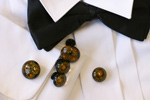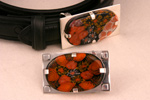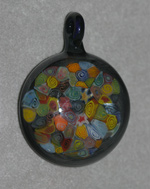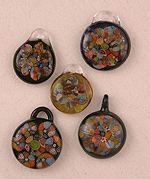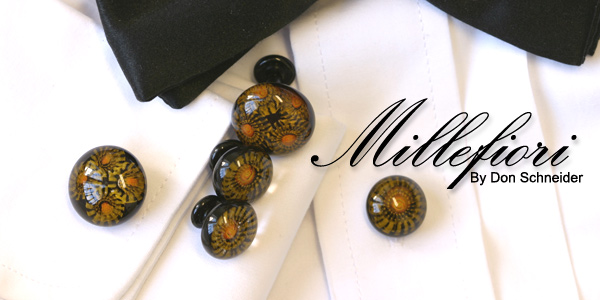
412-6
Millefiori
By Don Schneider
Millefiori – A Thousand Flowers
This specific design is built in layers.
First a clear ribbon of glass is created.
Then the colored glasses are readied for use.
The clear ribbon is laminated with the yellow ribbon. Once completely
fused the orange ribbon is applied over the yellow layer.
After this laminating process is complete they are rolled, clear layer
out, into a coil.
The coil is broken off the “punty” (glass handle) and reattached
at a right angle.
The coil is heated and marvered (glass is rolled on a plate to shape)
during which the design is narrowed and lengthened. At a point in this
process another punty is attached opposite the first punty so the design
can be heated and stretched to form the millefiori rod/cane.
After cooling cutting the rod reveals the pattern.
Using this new millefiori rod the design can continue to develop. Tubing
with yellow strips was prepared that were melted into the tube surface
and then stretched so the millefiori can be inserted into the end of the
tube. By melting the tubing around the millefiori, the design is enhanced
with a row of yellow dots. This process can be repeated forming a second
row of dots, and then again so the original millefiori spiral is now surround
by three rows of yellow dots.
Once cool the rod can be sliced into millefiori to reveal the pattern
as it will be used on finished pieces.
The earrings, tuxedo set (with glasss shanks) and the “progressive”
bead use this millefiori.
Composite Millefiori Pendant
This uses several millefiori rods of individual design. Cut to length
and fused together they make a composite millefiori rod typically consisting
of 7-9 individual rods.
Once fused, the rods-now one rod-can be stretched.
After the rod has cooled it can be cut into slices, in this case composite
millefiori.
For this style pendant, millefiori are laid out in the pattern to be “picked-up”
with a pad of clear glass.
The design is then melted into the clear glass pad surface.
The color pad that becomes the background is then applied
Numerous steps transfer the design back and forth until the clear layer
and the “bale” have been formed, after which the piece is
almost finished, the final step being the annealing process, where the
piece is allowed to cool slowly.
For more information about millefiori contact:
Don Schneider
The Glassworks
543 Deer Street
Plymouth, MI 48170
Phone: 734-459-6419
e-mail: dschneider@peoplepc.com
| Project Images | |
